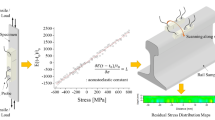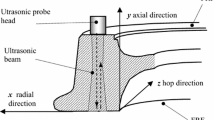Abstract
This paper presents an efficient method for stress measurement propagation. Pulse-echo method are used as stress measurement method on railway wheels. Hard service conditions and brake failures can lead to dangerous stress on the railway wheels. Stress measurements so important for wheels. Especially wheel expose to severe drag braking conditions in freight service. Residual stresses can significantly reduce the engineering properties and fatigue life of materials such as railway components. The paper presents results of stress state investigation of ER7 steel. Finally, the article briefly discusses how to adopt the pulse-echo method to railway wheels. Reducing cost of residual stress measurement investigated.
Similar content being viewed by others
References
F. Kafkas, The Design of the Computer-Aided Measurement Device Which Can Measure of Residual Stresses with Layer Removal Method, Master’s Thesis, Gazi University, Institute of Science and Technology, Ankara (2001).
R. Varol and F. Bedir, Importance of residual stresses and the effect on fatigue limit, Engineer and Machine, 34 (406) (1993) 38–41.
A. Parlane, Determination of residual stresses - A review of contemporary measurement techniques, Proc. Conf. on Residual Stresses in Welded Construction and Their Effects, (1978) 63–78.
J. Grum, S. Božič and M. Zupančič, Influence of quenching process parameters on residual stresses in steel, Journal of Materials Processing Technology, 114 (1) (2001) 57–70.
S. Jaap, Fatigue of Structures and Materials, Springer (2001).
P. J. Withers and H. Bhadeshia, Residual stress. Part 1—Measurement techniques, Materials science and Technology, 17 (4) (2001) 355–365.
N. Rossini et al., Methods of measuring residual stresses in components, Materials & Design, 35 (2012) 572–588.
C. Lonsdale, F. Demilly and V. Fabbro, Wheel rim residual stress measurements, Proceedings of The Railway Wheel Manufacturer’s Engineering Committee Technical Conference, Cp Lonsdale (Eds.), Chicago, Illinois (2000).
N. Tebedge, G. Alpsten and L. Tall, Residual-stress measurement by the sectioning method, Experimental Mechanics, 13 (2) (1973) 88–96.
R. Leggatt et al., Development and experimental validation of the deep hole method for residual stress measurement, Journal of Strain Analysis for Engineering Design, 31 (3) (1996) 177–186.
K. Watanabe et al., Strain gauge method for evaluating a three-dimensional residual strain state in wires, IEEE Transactions on Applied Superconductivity, 20 (3) (2010) 1420–1423.
G. Ruibin et al., Welding residual stress measurement of an urban buried gas pipeline by X-ray diffraction method, Insight-Non-Destructive Testing and Condition Monitoring, 57 (10) (2015) 556–561.
Z. Li et al., Internal stress monitoring of in-service structural steel members with ultrasonic method, Materials, 9 (4) (2016) 223.
H. Palkowski et al., Investigation on the residual stress state of drawn tubes by numerical simulation and neutron diffraction analysis, Materials, 6 (11) (2013) 5118–5130.
L. Mierczak, D. Jiles and G. Fantoni, A new method for evaluation of mechanical stress using the reciprocal amplitude of magnetic barkhausen noise, IEEE Transactions on Magnetics, 47 (2) (2011) 459–465.
H. Liu et al., Influence factors analysis and accuracy improvement for stress measurement using ultrasonic longitudinal critically refracted (LCR) wave, Applied Acoustics, 141 (2018) 178–187.
H. Hizli and C. H. Gur, Applicability of the magnetic barkhausen noise method for nondestructive measurement of residual stresses in the carburized and tempered 19crni5h steels, Research in Nondestructive Evaluation, 29 (4) (2018) 221–236.
F. Demilly et al., Wheel rim residual stress measurement using ultrasonic testing, Proceedings of the 13th International Wheelset Congress, Rome, Italy (2001).
A. Ekberg and E. Kabo, Fatigue of railway wheels and rails under rolling contact and thermal loading—An overview, Wear, 258 (7–8) (2005) 1288–1300.
C. Xu et al., Nondestructive testing residual stress using ultrasonic critical refracted longitudinal wave, Physics Procedia, 70 (2015) 594–598.
J. Szelazek, Ultrasonic evaluation of residual hoop stress in forged and cast railroads wheels—differences, Journal of Nondestructive Evaluation, 34 (1) (2015) 1.
Acknowledgments
This project was supported by the Scientific Research Projects Unit of Erciyes University (Project number: FDK-2017-7534).
Author information
Authors and Affiliations
Corresponding author
Additional information
Recommended by Associate Editor Jin Weon Kim
Emre Gorgun is a lecturer of School of Railway Systems, Cumhuriyet University, Sivas, Turkey.
Rights and permissions
About this article
Cite this article
Gorgun, E., Karamis, M.B. Ultrasonic testing to measure the stress statement of steel parts. J Mech Sci Technol 33, 3231–3236 (2019). https://doi.org/10.1007/s12206-019-0618-1
Received:
Revised:
Accepted:
Published:
Issue Date:
DOI: https://doi.org/10.1007/s12206-019-0618-1




